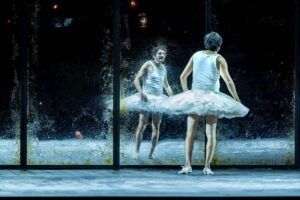
Opernhaus Zürich 2023-24 Review: Platée
By Laura ServideiThe Opernhaus Zürich presents a new production of a French Baroque masterpiece: “Platée,” a ballet-bouffon composed by Jean-Philippe Rameau in 1745. The premiere took place in Versailles as part of the festivities for the wedding of Louis XV with María Teresa Rafaela of Spain. The libretto, by Adrien-Joseph Le Valois d’Orville, draws inspiration from Greek mythology.
It narrates the tale of Platée, an amphibious and unattractive water nymph who perceives herself as the fairest of them all, believing that every man is enamored with her. In Olympus, Mercury and Momus (the god of mockery) orchestrate a joke to alleviate Juno’s jealousy towards her husband Jupiter. They deceive Platée into thinking Jupiter is infatuated and wishes to marry her. A sham wedding is organized, and when a furious Juno disrupts the ceremony to catch her husband in the act, she discovers the grotesque creature intended to be his bride, realizing it was all a prank.
The opera concludes with everyone ridiculing and laughing at a disheartened Platée. The narrative is notably harsh, as the unfortunate nymph’s only flaw is her foolish vanity; she never harmed anyone, yet becomes the victim of the gods’ cruel prank.
Baroque Opera, Then and Now
During the Baroque era, castrati reigned as opera stars across Europe, except in France, where the practice of castrating boys in hope of cultivating exceptional singers was deemed barbaric (they did have a point). In French Baroque opera, the haute-contre, a tenor with a remarkably high and agile voice, took center stage, foreshadowing the tenore di grazia of the bel canto period. Platée specifically calls for a haute-contre role. The tradition of casting men as unattractive (and/or elderly) female characters has ancient roots, persisting even in contemporary panto dames.
Director Jetske Mijnssen takes a modern approach by setting the narrative in a contemporary theater and reversing the sex of the central character. In this reinterpretation, Platée is portrayed as a man, specifically a gay prompter who desperately tries to insert himself into the performance, while Jupiter assumes the role of the lead male dancer (danseur étoile) in the ballet being practiced. This conceptual shift is notably bold: Mathias Vidal, the singer portraying Platée, may not be a supermodel, but he is a normally attractive person. He is not deliberately made up to appear uglier or grotesque in his portrayal. This prompts the question of why there is amusement and mockery surrounding the notion of Jupiter (a ballet dancer, no less) professing love for a man. While such a concept might be forgivable if it came from 1745, introducing it unexpectedly in a show in 2023 is, well, peculiar. There are also other less pivotal questions, such as why a ballet would require a prompter, but let’s not delve too deeply.
A Cast of Baroque Specialists
Vidal is a renowned specialist of this repertoire, and he lived up to expectations. His tenor effortlessly reaches the highest notes with a natural quality and apparent ease. The role is demanding: Platée is present on stage for the majority of the performance, with an exceptionally high vocal range and intricate ornamentation. Vidal’s coloratura was precise and agile, and his projection delivered a powerful and commanding interpretation. He gave his best in the furore pieces, such as “Quittez, nymphes, quittez” in the first act, and “Je brouillerai, je troublerai mon onde” in the end, where he really sounded menacing and emotional. Vidal was also appreciated for his acting abilities. In the pursuit of being acknowledged by the star dancer, Platée earnestly strives to become a part of the ballet corps. Convinced of being loved, he dons a tutu, resulting in a series of comedic incidents, with the real dancers making humorous attempts to evade collisions with him throughout various segments of the ballet music.
Evan Hughes portrayed Jupiter, showcasing a stentorian bass-baritone that was rich, smooth, and infused with a captivating, alluring edge. He performed admirably both as a singer and a danseur étoile: the show rehearsed was the iconic “Swan Lake” by Matthew Bourne, and Hughes really gave us his best relevé and tourné, donning the original costume, with feathery pants, naked torso and black makeup on his forehead. Mary Bevan portrayed La Folie, a character injecting a touch of madness into the performance, as if it required more! Bevan delivered an excellent rendition of “Aux langueurs d’Apollon,” the most elaborate aria in the entire opera. She executed each ornamentation with confidence, her coloratura sparkling and assured. Her high, silvery soprano featured exquisite and brilliant high notes, and she truly reveled in portraying the dance teacher, employing the picchiettati to encourage and reprimand the dancers.
A Plethora of Characters and a Great Conductor
Like many operas from the same period, “Platée” includes numerous “minor” characters. These roles were brought to life by specialists in the Baroque style, contributing significantly to the overall enjoyment of the performance. Despite being initially reported as in poor health, Renato Dolcini delivered a compelling performance as Cithéron and a Satyre. His deep baritone, supported by impeccable legato, remained strong, with only occasional notes exhibiting a slight “scratchiness.” Katia Ledoux left a lasting impression even in the minor role of Juno, Jupiter’s jealous wife. Her deep, bronzed mezzo and appropriately martial demeanor resonated throughout the theater, with great projection.
The cast included two additional haute-contre singers: Alasdair Kent in the role of Thespis and Nathan Haller as the god Mercury. Both exhibited remarkable ease in the upper register and possessed beautiful, brilliant timbres. Kent leaned towards a tenore di grazia style, displaying finesse, while Haller appeared more robust and powerful. Anna El-Khashem, taking on the roles of Clarine and Thalie, showcased a high, golden soprano with an impressive middle register. Notably, she portrayed one of the dancers rehearsing on stage, demonstrating extreme physical flexibility and a profound understanding of the movements. Tania Lorenzo Castro, portraying Amour, the god Cupid, sang with a high, silvery soprano. In the second act, she acted as an emcee in a cabaret setting in front of a glittering curtain.
The Zürich Opera Chorus, augmented with a few elements for the occasion, performed with enthusiasm. Their interventions were precise and cohesive, often seamlessly blending into dance music, more or less integrated into the story.
Emmanuelle Haïm, leading the orchestra La Scintilla which played on original instruments, provided a tight interpretation of the score. She maintained a brisk pace, guiding the action with a strong hand. Despite the occasional dryness in the sound, the orchestra produced generally beautiful tones with superb intonation. Haïm skillfully extracted every detail from the complex score, making audible nuances like bird songs, the hooting of owls, the waves conjured by Platée in the swamp, the wind, and Jupiter’s thunder. Ultimately, despite the whimsical plot and a somewhat perplexing production, Rameau’s extraordinarily modern music, skillfully conducted by Haïm and performed by a great cast, managed to shine through.



